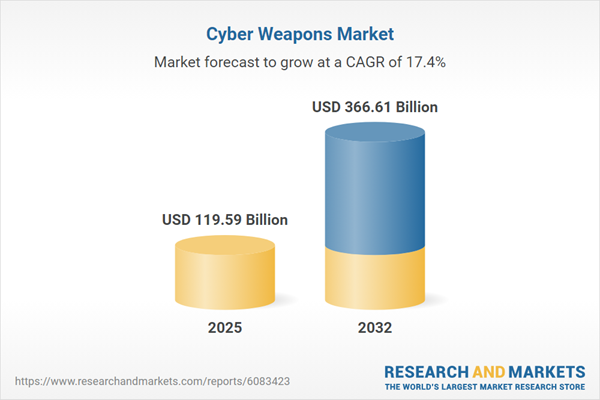Speak directly to the analyst to clarify any post sales queries you may have.
The cyber weapons market is rapidly influencing strategic decisions as organizations confront complex digital threats and evolving adversary tactics. Senior leaders must align resources and capabilities to address mounting operational risks and safeguard vital assets across global networks.
Market Snapshot: Cyber Weapons Market Size and Growth
The cyber weapons market expanded from USD 101.70 billion in 2024 to USD 119.59 billion in 2025 and is projected to grow at a compound annual growth rate (CAGR) of 17.38%, reaching USD 366.61 billion by 2032. Increasing geopolitical tensions, advances in technology, and frequent supply chain challenges are amplifying demand and volatility in this sector. Cyber weapons are now integral to national defense and commercial security planning, driving governments and enterprises to invest strategically in both offensive and defensive cyber capabilities as the threat landscape rapidly transforms.
Scope & Segmentation
This market intelligence report offers actionable insights across the essential segments, technologies, and regions shaping decisions in the cyber weapons market. Leaders gain visibility into sector composition to ensure resource allocation adapts in line with dynamic risks and regulations.
- Weapon Type: The landscape includes botnets targeting IoT and personal computers, DDoS tools at both application and network layers, exploit kits such as crimeware and drive-by methods, a spectrum of malware including fileless attacks, trojans, viruses, and worms, sophisticated phishing tools covering clone methods and spear-phishing, as well as ransomware variants and remote access trojans like keyloggers and backdoors.
- Attack Vectors: Multiple points of entry such as email, insider risks, mobile endpoints, network vulnerabilities, and exposures from web-based applications confront organizational defenses.
- Industry Verticals: Sectors impacted include banking, financial services and insurance, all branches of government, healthcare, IT and telecommunications, and retail environments from physical to digital commerce.
- Deployment Model: Organizations implement cloud, hybrid, and on-premise solutions to meet diverse regulatory, operational, and agility demands in their cyber defenses.
- Organization Size: Both large enterprises and small-to-medium businesses exhibit unique procurement strategies and threat intelligence requirements in response to risk appetite and budget constraints.
- Regions Covered: The analysis spans the Americas, Europe, Middle East and Africa with in-depth national breakdowns, and the Asia-Pacific region encompassing China, India, Japan, Australia, and additional high-growth markets.
- Leading Companies: Lockheed Martin, Boeing, Raytheon Technologies, Northrop Grumman, General Dynamics, BAE Systems, L3Harris Technologies, Leonardo, Thales Group, and Leidos Holdings are shaping advances and providing solutions within the sector.
Cyber Weapons Market: Key Takeaways for Decision-Makers
- AI, machine learning applications, and scalable cloud architectures are elevating cyber weapon capabilities, outpacing conventional defense strategies for state and private sector actors.
- Adoption of IoT and advanced network topologies compels organizations to bolster detection and recovery operations, emphasizing real-time resilience alongside traditional prevention measures.
- Global regions exhibit diverse responses: The Americas place emphasis on cooperative models between industry and government, Europe and the Middle East advance harmonized regulation, and Asia-Pacific invests in technology-driven security supported by strong state policies.
- Defensive frameworks are shifting from perimeter-focused approaches toward intelligence-led, adaptable security models capable of responding to emerging and previously unknown attack techniques.
- Collaboration involving technology vendors, academia, and open source innovators accelerates solution development and propagation, while also raising new considerations about adversary capabilities.
- Critical industry verticals such as finance, healthcare, and the public sector are persistent targets, prompting investments in managed detection, incident response, and strategies to secure extended supply chains.
Tariff Impact: United States Tariffs Reshaping Supply Chains
Recent United States tariffs on advanced semiconductor and networking components are influencing procurement and supply network strategies throughout the cyber weapons ecosystem. Suppliers have adopted modular architectures to manage regulatory fluctuations, while adversaries redirect investments into domestic innovations and alternative sourcing. Organizations are reviewing digital provenance and purchasing practices, bolstered by open source and academic initiatives that mitigate capability gaps from restricted imports. These actions are redefining the market for both attack and defense tools across regions.
Methodology & Data Sources
This research applies a structured method, integrating open source intelligence, literature reviews, and expert interviews from military, academic, and commercial sources. Analytical segmentation covers weapon type, delivery method, vertical market, and deployment format. Results are validated through vendor and procurement data, incident analysis, and scenario-based simulations, providing a comprehensive view of supply chain and security exposure.
Why This Report Matters
- Empowers senior executives to anticipate disruptive technology trends and regulatory developments, optimize cyber defense budgets, and make procurement decisions grounded in strategic market insight.
- Clarifies the impact of shifting global policies and tariff regimes on technology selection, vendor management, and international cooperation for more resilient digital strategies.
- Supports organizations in strengthening defenses against evolving threats across jurisdictions, enabling robust and forward-looking security planning.
Conclusion
The cyber weapons market remains defined by accelerated technological change and regulatory movement, as well as increasingly sophisticated threat actors. Intelligence-driven investment and sector collaboration will remain vital for achieving strong, adaptable security in a globally contested domain.
Table of Contents
3. Executive Summary
4. Market Overview
7. Cumulative Impact of Artificial Intelligence 2025
Companies Mentioned
The companies profiled in this Cyber Weapons market report include:- Lockheed Martin Corporation
- The Boeing Company
- Raytheon Technologies Corporation
- Northrop Grumman Corporation
- General Dynamics Corporation
- BAE Systems plc
- L3Harris Technologies, Inc.
- Leonardo S.p.A
- Thales Group
- Leidos Holdings, Inc.
Table Information
| Report Attribute | Details |
|---|---|
| No. of Pages | 188 |
| Published | October 2025 |
| Forecast Period | 2025 - 2032 |
| Estimated Market Value ( USD | $ 119.59 Billion |
| Forecasted Market Value ( USD | $ 366.61 Billion |
| Compound Annual Growth Rate | 17.3% |
| Regions Covered | Global |
| No. of Companies Mentioned | 11 |









